April 29, 2025
GWADAR – The sea that once sustained generations is now stripped by deep-sea trawlers, leaving Gwadar’s fishermen adrift and uncertain.
In Gwadar’s Padi Zer, where the towering silhouette of Koh-i-Batil meets the endless shores of the Arabian Sea, the fishermen push their boats into the surf as the evening tide rolls in. The sun casts golden shadows over the water as others offload their modest haul from ice boxes.
A small crowd gathers, murmuring with hope, asking for fish to take home. But the replies come tinged with disappointment, echoing in Balochi: “Mahee ady jend nest” (there’s no fish today). Still, a few kaashuk-loojar (sardines) are handed out, small offerings from a sea that gives only just enough. The process takes over an hour, as the sparse catch is finally carted off in qingqi rickshaws to fish trading companies.
As the sun sinks lower, one of the sailors returns to Padi Zer, now seated across Waado Aani Jah — the boat makers’ point — alongside other fishermen sipping their chai ordered from a nearby teashop. The salt still clings to his skin, his clothes still carrying the scent of the sea. You wonder aloud how he’s found the time to return, barely bathed, barely rested. He offers a knowing smile and says:
“I return to remind myself — and my conscience — that we don’t turn to the sea just for a living, we belong to it. No matter the odds and challenges.”
Yet, beyond these shores, new boundaries appear. The same people who have always lived by the sea now find themselves edged out of places they once moved through freely.
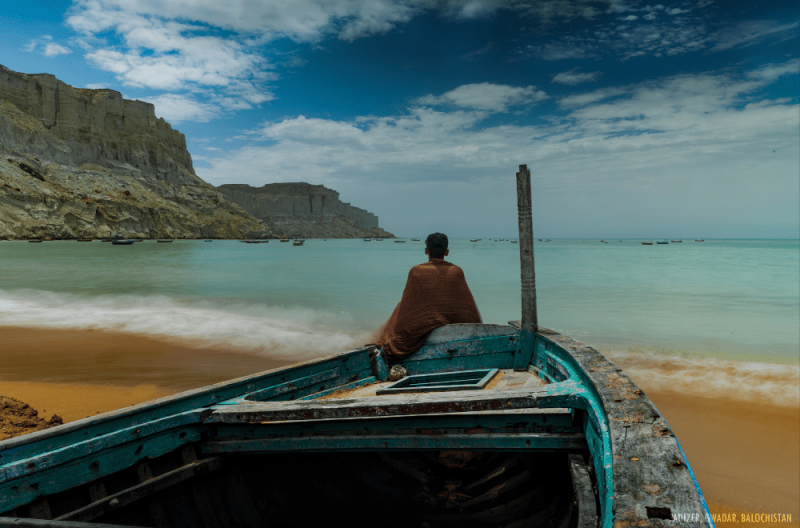
Where Koh-i-Batil meets the Arabian Sea. PHOTO: DAWN
Koh-i-Batil — the heart of Gwadar’s landscape — spans vast across the landscape. From its peak, the entire city stretches out in a breathtaking panorama: sunlit waters, winding roads, the pulse of a city shaped by sea and stone. But today, this landmark is a restricted area. Visitors have to wait, present their IDs, and are often denied access altogether. Even those allowed through are confined to a single section of the mountain.
One can’t help but think: Did the indigenous people of Gwadar ever imagine that “development” would fence them out of their own heritage? Can progress truly uplift a community if it erases their access to the very spaces that gave them meaning?
Enter: CPEC
Gwadar, a dusty city along the arid coastline of the Arabian Sea, has been in the headlines for over a decade as a key player in China’s economic ambitions. Situated in Pakistan’s volatile Balochistan province near the Iranian border, it has been thrust into the spotlight as a key node in the Belt and Road Initiative (BRI) — a large-scale infrastructure and economic development project initiated by China in 2013. Amid barren deserts and jagged mountains, this remote city is being fantasised as the next big commercial hub, a gateway for Chinese trade and investment into the region.
Home to an indigenous Baloch fishing community, the city is home to approximately 100,000 residents whose lives are still defined by hardship. Electricity is sourced from across the border in Iran, but it’s erratic at best. And while CPEC’s vision has yet to bring tangible change to Gwadar, the city’s struggles don’t end there. More than the economic exclusion, the sea itself, seems to be slipping away. Clean water is scarce and the once-abundant sea now yields little more than scraps, picked over by industrial deep-sea trawlers before reaching local shores.
It’s no secret that Gwadar is reeling from the impact of deep-sea trawling. As fish disappear from its waters, indigenous fisherfolk are left struggling to sustain their way of life.
The 750km coastline of Balochistan — including towns and cities such as Gwadar, Pasni, Ormara, Ganz, Pishukan, Jewani, Surbandan, along with surrounding fishing villages — has long supported communities that lived in harmony with the sea. However, illegal, unreported, and unregulated (IUU) deep-sea trawling has crippled local fish production and inflicted lasting damage on the marine ecosystem.
Saki Baksh, a fisherman from Gwadar, explained the scale of the crisis: “Even 10 days of our hard work at sea can’t match what a single trawler catches in one day.”
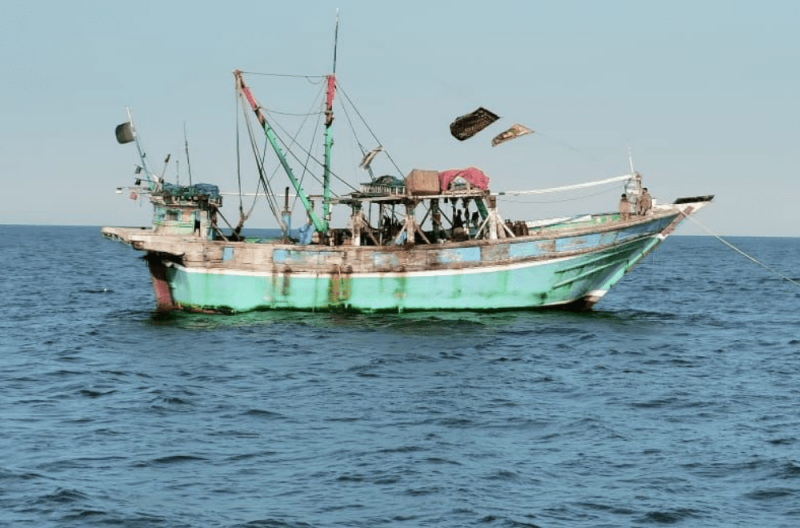
A deep-sea trawler in Gwadar. PHOTO: DAWN
Fishing practices: Local fishermen vs deep-sea trawlers
Local fishermen have traditionally followed sustainable fishing practices, aligning their methods with seasonal availability. They adapt their nets based on the type of catch — for example, during the king fish season (September to November), they target only king fish, avoiding other species. The same approach applies to lobsters, shrimps, and other seafood. They mostly use eco-friendly nets with large holes and minimal plastic, allowing vulnerable marine species to escape, thereby preserving the marine ecosystem.
In recent years, however, some local fishermen have begun using harmful gear such as fine plastic mesh nets, small-holed nets, encircling nets, and wire nets — locally known as gujja. These practices pose a serious threat to marine biodiversity and contribute to the depletion of fish production. Hence, such nets are prohibited under the Balochistan Fisheries Ordinance, 1971.
Nako Chakar, an 80-year-old former fisherman, no longer goes to sea but still walks the Gwadar shoreline, listening to the fishermen as they unload their catch. Their conversations tell a different story now — of vanishing fish, changing nets, and a sea no longer as generous.
“When your livelihood depends on something, you treat it with care,” he reflected. “For us, the sea was sacred. I remember waiting for my father’s return with the day’s catch. My sons once waited for me the same way. Now I watch them return frustrated, cursing the trawlers that swept away the fish from their nets.”
“We used to catch fish with ease, each season bringing its own bounty,” he reflected. I would ride a camel to nearby towns to sell our catch. But when the trawlers arrived, we didn’t realise what was coming. We just saw big boats — never imagining they’d end up destroying our coast.“
Local fishermen operate in small, single-engine boats that allow them to navigate carefully without disrupting others or risking collisions. In contrast, deep-sea trawlers — large vessels with around 40 crew members — move at high speeds, often crashing into these smaller boats and causing significant damage.
While local fishermen work 12-hour shifts, trawlers operate around the clock. Equipped with three engines, generators, diesel fuel, and ice storage, they tow massive nets that sweep both surface and deep-sea fish. Their fine-mesh plastic nets, also known as gillnets, trap even the smallest fish, pushing certain species toward extinction.
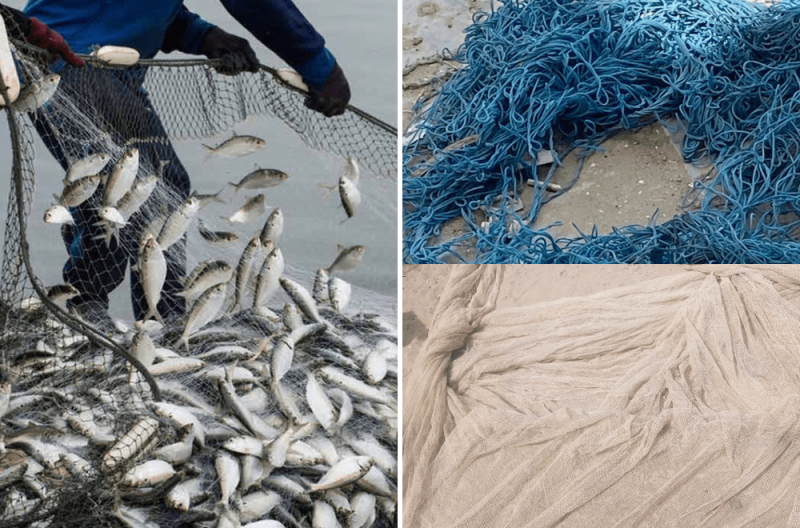
Left: Local fishermen use this net to catch sardines and Indian mackerel. Right: Two types of nets used by deep-sea trawlers. PHOTO: DAWN
Unsurprisingly, the actions of deep-sea trawlers have become rather brazen today; they frequently detain, attack, and intimidate local fishermen. On May 28, 2024, an incident in Gwadar saw a trawler crew murder a local fisherman and abduct another. In response, fishing communities and local activists launched protests, blocking major highways. Outraged by the unchecked violence and looting, they decried that deep-sea trawlers operate with impunity under the protection of powerful authorities and remain above the law.
According to one fisherman, who spoke on condition of anonymity, encounters with trawler crews can be dangerous. “They are often armed. If a local boat crosses their path, they don’t hesitate to fire warning shots,” he said.
Aziz Peer Baksh, CEO of Atlantic Seafood Company, a locally owned enterprise in Pasni, also pointed to the destructive practices of large trawlers operating in the region. He said that the trawlers transport their catch to Karachi, where it is processed for export. “They often capture massive bycatches — including turtles, dolphins, sharks, whales, and squid — which they sell to seafood companies at low prices,” he claimed.
According to Baksh, the production of key species such as sardines, Indian mackerel, green mussels, pomfret, mud crabs, sole fish, shrimp, and prawns has plummeted. “This sharp decline has pushed our incomes to the brink of collapse and endangered marine life,” he added. “Local fishermen and sailors who once supplied fish across Balochistan and Karachi are now struggling. The reason is clear: they are bringing in fewer fish than ever before.”
Where does the rest of the world stand?
International legal instruments such as the United Nations Convention on the Law of the Sea (UNCLOS), 1982, United Nations General Assembly (UNGA) resolutions (61/105, 64/72, 66/68, 71/123), and international guidelines on fishing by the Food and Agriculture Organisation (FAO) call for urgent action to conserve and manage vulnerable marine ecosystems (VMEs) in the high seas.
Moreover, Goal 14 of the Sustainable Development Goals (SDGs) calls for the sustainable management and protection of marine ecosystems. As a result, several countries, including the United States, Canada, New Zealand, and Australia, have either banned or regulated commercial fishing by deep-sea trawlers in vulnerable areas.
Ellie Hooper, an oceans campaigner at the Greenpeace Aotearoa — one of New Zealand’s largest environmental organisations — explained in an article that bottom trawlers use various types of nets indiscriminately, regardless of the fish’s seasonal availability. This approach threatens marine life, as species are caught regardless of their breeding seasons. Trawlers drag large and heavy nets across the sea floor, plowing through biologically rich and diverse ecosystems, crushing corals, sponges, various aquatic species and their habitats as they go.
For this reason, bottom trawling has a large bycatch impact, with many non-target species being fished in the process. The article further stated that “dragging heavy nets across the seabed disturbs marine sediments, which is the world’s largest carbon sink”, highlighting the practice’s significant contribution to climate change.
In 2021, a groundbreaking study published in Nature, an international journal, revealed that fishing boats using heavy nets to trawl the seafloor — often at great depths — release as much carbon dioxide as the entire aviation industry.
Moreover, according to the Second World Ocean Assessment (WOA II), “fishing, especially bottom trawling, constitutes the greatest current threat to seamount ecosystems”.
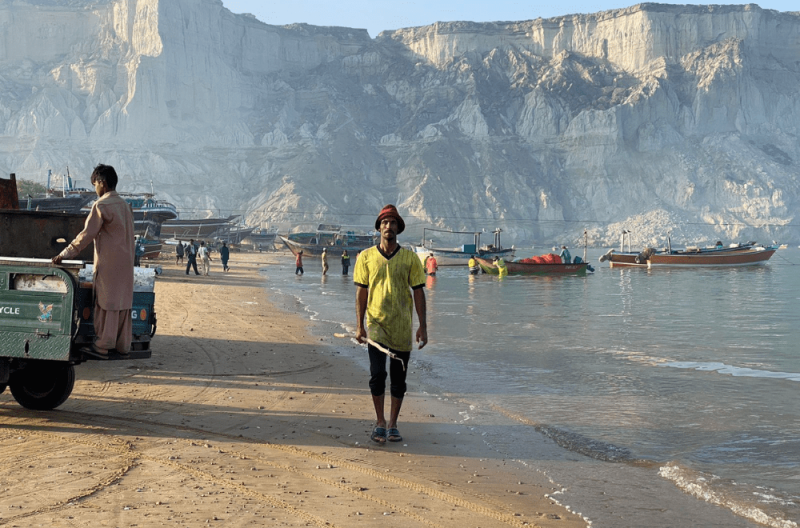
A fisherman strolls the Gwadar coast, surrounded by rugged cliffs and anchored boats. PHOTO: DAWN
The official stance
As per the Balochistan Sea Fisheries Ordinance of 1971, the Secretary of Fisheries and Coastal Development has imposed a ban on all types of fishing in Balochistan’s territorial waters from June 1 to July 31 each year, to protect marine life during the breeding season.
Ahmad Nadeem, an official from the Marine Fisheries Department in Balochistan, explained that fishing is strictly prohibited during this period to allow fish populations to breed and replenish. “However, even during this period, many fishermen continue to sneak into the waters, and one month is simply not enough for the sea to recover,” he added.
Overfishing has led to a sharp decline in fish populations, with many fish being caught before reaching maturity. “Like all living creatures, fish need time to grow, but they’re often caught at the larval stage,” he explained.
He noted that fishing practices have drastically changed over time. In the past, small-scale fishermen would spend only three to four hours at sea, while larger boats stayed out for seven to 10 days. Today, smaller boats are staying out for as long as eight hours, with some even making multiple trips within a 24-hour window.
“The pressure to earn quick profits has placed an immense burden on the sea,” he added.
According to him, fishing techniques have also changed significantly, with modern nets featuring smaller mesh sizes and stretching over much longer distances — ranging from five to 30 kilometres (km) — compared to the larger, shorter nets used in the past. He added that previously, fishermen targeted specific species based on season and demand. Today, they catch whatever they can find, driven by market needs. “Every size and type of fish is now bought, further worsening overfishing,” Nadeem said.
“Deep-sea trawlers are to be blamed for the use of fine mesh nets, rampant overfishing, increasing number of boats, destructive fishing techniques, and the disregard for seasonal restrictions. These practices have caused irreversible damage,” the official acknowledged.
Though legal frameworks such as the Sindh Fisheries Ordinance of 1980 and the Balochistan Sea Fisheries Ordinance of 1971 are in place to protect vulnerable marine species — including various types of sharks — their enforcement remains largely ineffective. For instance, the Marine and Fisheries Department in Gwadar confirmed that the Karinj (Mobula) is now extinct, with only 17 recorded sightings between 2021 and 2022. The sawfish has disappeared entirely.
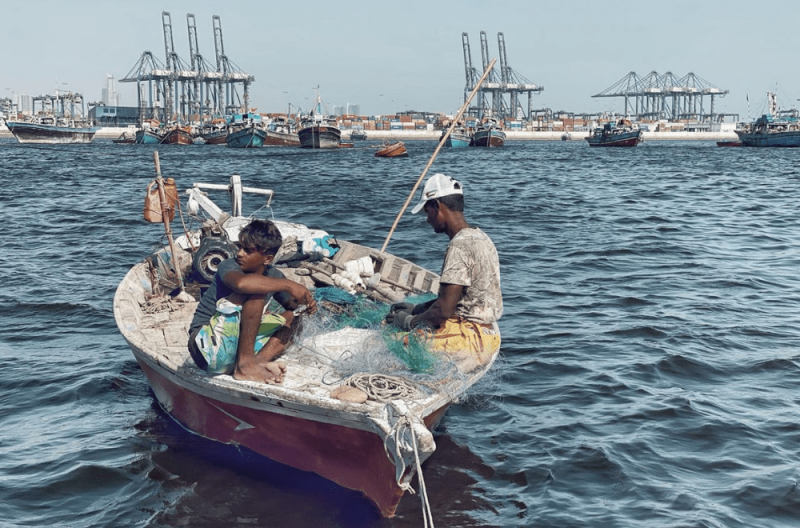
Fishermen tend to their nets on a boat. PHOTO: DAWN
The impact on Gwadar’s fisheries and fisherfolk
Shamsi, a resident of Gwadar, sat cross-legged with a small pile of sardines in her lap. Her trembling, wrinkled hands moved slowly as she cleaned the catch of the day. “Sardines have lost their shape,” she muttered. “They were always tiny, full of thin, nearly invisible bones — but they had taste. Now, they’re even smaller, and when we fry them, there’s no flavour.”
Her 19-year-old son, Sameer, is a fisherman — one of the many who brave the unpredictable sea each day. “He risks his life out there,” she says, “and comes back with nothing but disappointment and a few measly fish.
Like countless other families along the coast, Shamsi’s household relies on the sea for survival. But as fish stocks shrink, the entire community is at the brink of poverty and hunger. “The fishermen return with empty nets and fading hopes,” she lamented. “Indian mackerel and Hilsa fish — locally known as Palwar — were once plentiful. Now, most of our favourite fish have disappeared. The real culprit is the deep-sea trawlers that are ruthlessly stripping our waters bare.”
Her story mirrors that of Nako Shambay, a fellow coastal dweller grappling with a similar struggle. For over 45 years, he has navigated the waters off Gwadar’s coast. As a seasoned sailor, he’s faced fierce winds and the unforgiving pull of the sea. “There were days I thought I wouldn’t make it back,” he reflected. “The reality of this life is that it’s harsh, unyielding, but the only source of income we’ve known.”
Shambay recalled his childhood, casting nets beside his father who steered the boat. “Back then, Hilsa fish were so plentiful that even children could catch them with bare hands. As the years have passed, I have gone from being a fisherman to a boat nahuda (sailor) but there’s no trace of Palwar anymore.”
He claimed that the growing number of deep-sea trawlers over time has pushed several marine species to the brink of extinction. Among those that have disappeared are the Pishik (a small shark), Soli (sole fish), Gallow (sea catfish), Soro (king soldier bream), and various shark species.
“I remember when sharks were always around,” the sailor added. “Sometimes they tore through our fishing gear. But we never hunted them — our elders taught us to respect and protect certain sea creatures. Now, even those are gone. What we see instead are massive trawlers, wrecking our boats and emptying the sea.”
Another fisherman Chakar reminisced about a simpler time when fishing was more than just an industry. “We fished according to the time of the day. We would leave at shab rech (night) and return in the morning, relaxed and content. Life was tough, but the sea was alive. We fished to feed our families, not for profit. Now, the sea feels empty.”
“Today, Palwar, Garme pagas, Kail, Guthol, Warok, Gorchok, and Kalgon are rarely seen. It’s been over 15 years since I last saw a Soleeg. Even Kir is so scarce now that catching one is considered a stroke of luck,” he added.
Deep-sea trawlers from Karachi and other parts of Sindh routinely encroach upon the Makran coast, despite not being local to the region. Their activities are not only unwelcome but also illegal. By law, they are prohibited from operating within 12 nautical miles of a country’s Exclusive Economic Zone (EEZ), and larger vessels must remain at least 35 miles from the shoreline. Yet, these regulations are routinely flouted.
“There is an entire chain of officials who take bribes from the trawler mafia, turning a blind eye to these violations,” said KB Firaq, a Baloch educator and social activist from Gwadar. “Anyone standing on the shore can see trawlers openly fishing in Gwadar’s waters.”
A local fish trader Rasheed from Pasni echoed this concern, alleging that the Fisheries Department receives substantial bribes from deep-sea trawler operators, which is why they are able to operate freely without any restrictions.
Nadeem, director of the said department, acknowledged that while the department is large and it’s possible that some individuals may be involved in corrupt practices, there is no confirmed evidence to support such claims.
He further elaborated on the difficulties in enforcing fishing regulations, particularly when it comes to monitoring vast stretches of the sea. “The sea is huge — it can’t be monitored like a road. By the time we receive information and reach the spot, the deep-sea trawlers have usually fled. In today’s social media age, fishermen often post videos online instead of informing local fisheries coordinators, which delays our response. These posts sometimes alert the trawler operators as well, giving them time to escape. If we’re properly informed and fail to act, we can be held accountable,” he stated.
His words, however, hold little solace for Nahuda Khuda Dost Wajo, a sailor and president of the Mahigeer Ittehad — which fights for the fisherfolk’s rights. “The trawlers have already destroyed other seas, and now they are doing the same to ours. At this rate, we’ll have no catch left in two years.”
The impact of overfishing has also changed the economics of the industry. The value of fish — once determined by size, weight, and shine — has diminished. “Fish don’t get a chance to grow or mature anymore. Their size has shrunk, their luster has faded,” Wajo lamented.
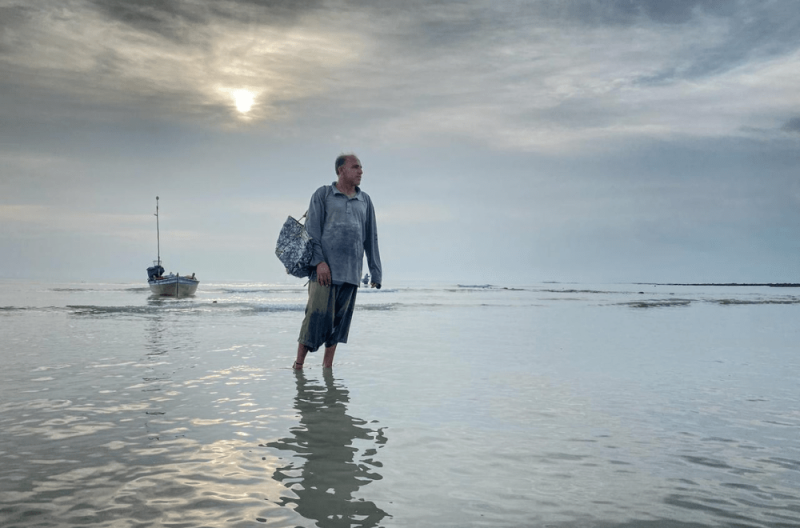
A local fisherman stands in shallow waters at dawn. PHOTO: DAWN
Local grievances unheard
According to Wajo, the issue of deep-sea trawling is not new — it is a longstanding problem that continues to threaten Balochistan’s coastal communities and marine ecosystem. “In the past, international deep-sea trawlers respected the boundary,” he stated.
Hafeez Kiazai, General Secretary of Haq Do Tehreek (HDT), noted a turning point when both the Sindh and Balochistan governments began issuing licenses to Pakistani trawlers from Sindh. These vessels started encroaching into Balochistan’s territorial waters, violating the ordinance and exacerbating tensions with local fishing communities.
“When the government realised the lucrative potential of trawling, they prioritised revenue over regulation,” Kiazai alleged. “They began accepting money from trawler owners and expanded their access to the sea.”
As frustration mounted, local communities began to resist. Between 2005 and 2006, a grassroot movement called Trawler Bhagao, Choola Jalao (remove trawlers, light your stoves) emerged in protest but failed to halt illegal trawling, which has continued unchecked till date, added Khuda Dost.
The latest wave of protests began in Gwadar and has since spread to Lasbela district, underscoring the growing anger and desperation among coastal residents.
Kiazai blamed the inefficiency of the Balochistan Fisheries Department for the ongoing crisis. “The department has never taken effective action against trawlers. When a vessel is seized, its catch is sold off, but the trawler is often returned to its owners after legal action. There’s no deterrence — trawling just continues,” he explained. “Why, then, should the government even issue licenses for these larger boats to exploit the province’s waters?”
Khuda Dost voiced a deeper concern: “The law forbids trawlers from entering the 12 nautical mile zone, but our demand goes beyond that. We oppose all forms of trawling. If there is nothing left in the sea, there is nothing for the people living near it.”


